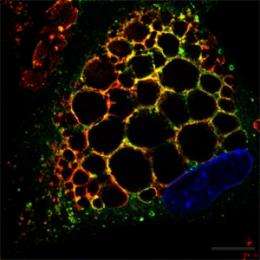Opening the gate to the cell's recycling center

(PhysOrg.com) -- In cells, as in cities, disposing of garbage and recycling anything that can be reused is an essential service. In both city and cell, health problems can arise when the process breaks down.
New research by University of Michigan cell biologist Haoxing Xu and colleagues reveals key details about how the cell's garbage dump and recycling center, the lysosome, functions. These insights, which may lead to better understanding of conditions such as amyotrophic lateral sclerosis (ALS, also known as Lou Gehrig's disease) and Charcot-Marie-Tooth (CMT) disease, suggest new avenues of treatment for these and other diseases that cause nerves and muscles to malfunction.
The research, published this week in the online, multidisciplinary journal Nature Communications, focused on gateways called calcium channels in the lysosome membrane. Calcium channels, which also are found in the membranes surrounding muscle and nerve cells, are made of proteins that respond to signals in the form of electrical impulses. When the proper signal comes along, the proteins open the channel, allowing calcium to pass through. The calcium, in turn, triggers some vital process such as muscle contraction or the release of a hormone or neurotransmitter (a chemical messenger involved in nerve transmission).
Scientists know a lot about the workings of calcium channels in the surfaces of muscle and nerve cells, but understanding what goes in the lysosome---a tiny pouch hidden inside the cell---has been a challenge, said Xu. Consequently, the exact identity of the protein involved and how it becomes activated have remained a mystery.
To explore the channel and its workings, Xu's group modified a technique known as the patch clamp, in which a scaled-down pipette and electrodes are attached to a cell membrane to record the activity of one or more proteins making up the channel. With their modification, which they call the lysosome patch clamp, the researchers determined that a protein called TRPML1 serves as the calcium channel in lysosomes and that a lipid known as PI(3,5)P2 carries the signal that activates the protein.
This particular protein and lipid aren't obscure characters previously unknown to science. A mutation in the gene that produces TRPML1 is known to cause Type IV mucolipidosis (ML4), a genetic disorder that affects mainly Jews of Eastern European background and results in mental retardation, poor vision and diminished motor abilities. And mutations in the enzymes needed to make PI(3,5) P2 cause a variety of neurodegenerative diseases including ALS and CMT.
The protein TRPML1 also is of interest because of the unusual way it does its work.
"While other channel proteins are in the 'passenger' seats of the membrane traffic, TRPML1 is in the 'driver' seat," said Xu, an assistant professor of molecular, cellular and developmental biology. This suggests that manipulating TRPML1 channel activity using channel activators or inhibitors could affect membrane traffic.
"If you can activate the channel, it might be possible to overcome the membrane traffic defects caused by the disease-causing mutations. Luckily, small-molecule chemicals that can stimulate TRPML1 channel activity are already available, " Xu said.
He and collaborator Miriam Meisler, a human genetics professor at the U-M Medical School, have experiments underway to see if they can prevent or reverse the course of disease in a mouse model of ALS by increasing activity of the TRPML1 channel.
If the strategy is successful, Xu hopes to explore its use in treating other neurological diseases.
"If the system we're studying turns out to be compromised in more common diseases, the method of increasing channel activity could have important implications for their treatment," he said.
More information: Nature Communications: www.nature.com/ncomms/index.html
Provided by University of Michigan















